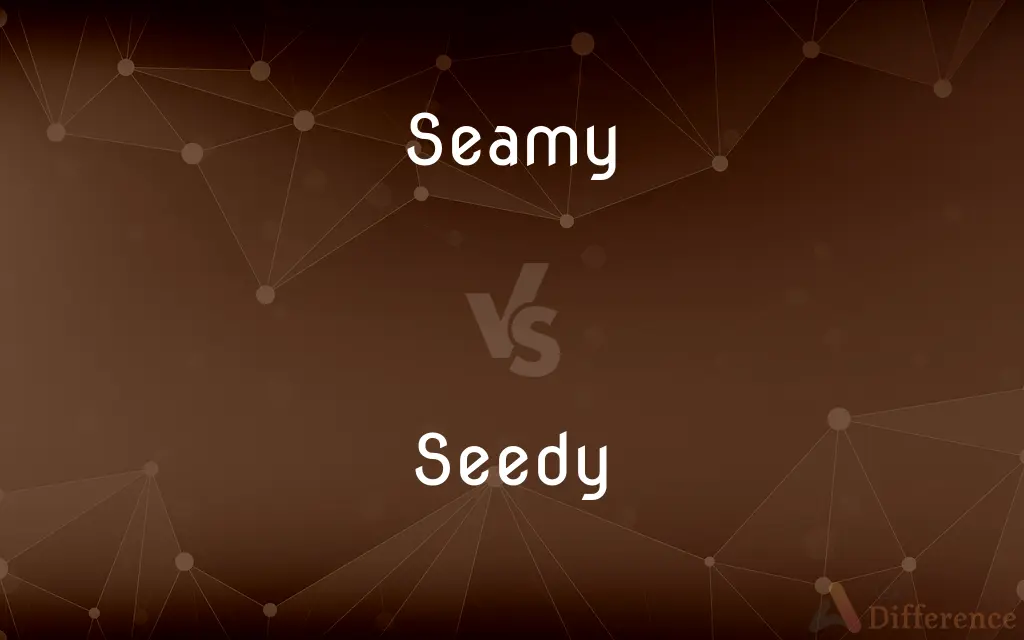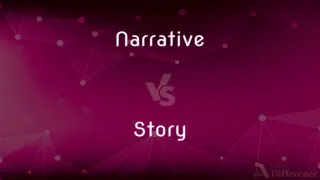Seamy vs. Seedy — What's the Difference?
By Fiza Rafique & Maham Liaqat — Updated on March 26, 2024
Seamy refers to the morally degraded side of something, while seedy suggests dilapidation or disrepute, often implying moral looseness.

Difference Between Seamy and Seedy
Table of Contents
ADVERTISEMENT
Key Differences
Seamy highlights the morally unsavory or sordid aspect of life or a place, focusing on the darker, hidden sides that are often concealed from public view. It implies a deep level of moral or ethical degradation. Whereas, seedy is used to describe places or people that appear run-down, disreputable, or of low moral character, suggesting not just moral looseness but also physical dilapidation or neglect.
The term seamy often evokes images of the hidden, darker aspects of society, such as crime, corruption, or sexual immorality, which are usually kept out of sight or are underlying. Seedy, on the other hand, conveys an overt sense of neglect or disrepair, often applied to locations (like hotels, bars, or neighborhoods) that visibly appear unkempt or disreputable and might attract questionable activities.
Seamy can be used to describe the underside of human activities or institutions, where the focus is on the ethical or moral decline hidden beneath the surface. It’s the side of things that society prefers to ignore or hide. In contrast, seedy places are often in plain sight, their state of disrepair and the character of their inhabitants or patrons plainly visible, signaling a decline in both moral and physical standards.
In literature and film, a seamy setting might be used to explore complex, morally ambiguous themes, offering a deep dive into the darker aspects of human nature or societal failings. A seedy setting, however, typically sets the stage for a more immediately recognizable backdrop of decay, both moral and physical, often used to highlight neglect, poverty, or the fringes of society.
Both terms, while similar in their negative connotations, are used distinctively in language to depict the varying degrees of moral and physical degradation. Seamy suggests a hidden, morally corrupt underside, while seedy is more overt, signaling both moral and physical decay visible to the eye.
ADVERTISEMENT
Comparison Chart
Definition
Morally unsavory or sordid, hidden from public view.
Appearing run-down or disreputable, implying moral looseness.
Connotations
Moral or ethical degradation, hidden aspects.
Physical dilapidation, overt neglect, moral decline.
Usage
Describes darker, hidden sides of life or institutions.
Applied to visibly neglected or disreputable places/people.
Literary Use
Explores deep, morally ambiguous themes.
Sets a backdrop of decay, neglect, or societal fringes.
Visibility
Hidden moral or ethical decline.
Overt physical and moral decay.
Compare with Definitions
Seamy
Morally degraded or sordid.
The film peels back the city's glamorous facade to reveal its seamy underbelly.
Seedy
Run-down, in a state of disrepair.
They entered a seedy bar on the outskirts of town.
Seamy
The darker side of society, hidden from view.
His novel explores the seamy side of urban life in the 1980s.
Seedy
Neglected, unkempt, suggesting moral decay.
The once-grand hotel now looked seedy and forgotten.
Seamy
Hidden moral or ethical degradation.
The documentary exposed the seamy aspects of the fashion industry.
Seedy
Signaling decline in both morals and appearance.
The city’s seedy districts were avoided by locals and tourists alike.
Seamy
Ethically questionable or corrupt.
The seamy dealings of the corporation were eventually brought to light.
Seedy
Disreputable, of questionable morality.
The neighborhood was known for its seedy characters.
Seamy
The unsavory part of life.
Despite its beauty, the city has a seamy side that tourists seldom see.
Seedy
Physically dilapidated and morally loose.
His seedy appearance made others wary of him.
Seamy
Sordid; base
"seamy tales of aberrant sexual practices, messy divorces, drug addiction, mental instability, and suicide attempts" (Barbara Goldsmith).
Seedy
Having many seeds.
Seamy
Having, marked with, or showing a seam.
Seedy
Resembling seeds or a seed.
Seamy
Sordid, squalid or corrupt.
Seedy
Worn and shabby; unkempt
"He was soiled and seedy and fragrant with gin" (Mark Twain).
Seamy
Having or showing a seam.
Seedy
Somewhat disreputable; squalid
A seedy hotel in a run-down neighborhood.
Seamy
Having a seam; containing seams, or showing them.
Everything has its fair, as well as its seamy, side.
Seedy
Chiefly British Tired or sick; unwell.
Seamy
Morally degraded;
A seedy district
The seamy side of life
Sleazy characters hanging around casinos
Sleazy storefronts with...dirt on the walls
The sordid details of his orgies stank under his very nostrils
The squalid atmosphere of intrigue and betrayal
Seedy
Full of seeds.
Pomegranates are as seedy as any fruit you are likely to see.
Seedy
(figurative) Disreputable, run-down.
Seedy
Untidy; unkempt.
His seedy, dirt-smudged visage caused her to look at him askance.
Seedy
Infirm; unwell; gone to seed.
With her aching back and pronounced limp, she was feeling particularly seedy today.
Seedy
Suffering the effects of a hangover.
After last night’s party we were all feeling pretty seedy.
Seedy
Having the flavour of seeds.
Seedy
(colloquial) Having a peculiar flavour supposed to be derived from the weeds growing among the vines; said of certain kinds of French brandy.
Seedy
Abounding with seeds; bearing seeds; having run to seeds.
Seedy
Having a peculiar flavor supposed to be derived from the weeds growing among the vines; - said of certain kinds of French brandy.
Seedy
Old and worn out; exhausted; spiritless; also, poor and miserable looking; shabbily clothed; shabby looking; as, he looked seedy; a seedy coat.
Little Flanigan here . . . is a little seedy, as we say among us that practice the law.
Seedy
Full of seeds;
As seedy as a fig
Seedy
Shabby and untidy;
A surge of ragged scruffy children
He was soiled and seedy and fragrant with gin
Seedy
Morally degraded;
A seedy district
The seamy side of life
Sleazy characters hanging around casinos
Sleazy storefronts with...dirt on the walls
The sordid details of his orgies stank under his very nostrils
The squalid atmosphere of intrigue and betrayal
Seedy
Weak and feeble;
I'm feeling seedy today
Common Curiosities
Is seedy always negative?
Yes, seedy carries a negative connotation, suggesting both physical neglect and moral looseness.
Can a place be both seamy and seedy?
A place can exhibit both qualities, with a seedy exterior and seamy, hidden aspects of moral or ethical degradation.
How does seamy relate to societal issues?
Seamy often highlights societal issues like corruption or crime that are prevalent but not always visible to the public eye.
What is the main difference between seamy and seedy?
Seamy refers to the morally unsavory aspects hidden from view, while seedy describes places or people that are visibly run-down and of low moral character.
Can a story have both seamy and seedy elements?
Yes, a story can explore both the hidden moral corruption (seamy) and the visible decline (seedy) of its setting or characters.
How do authors use seedy settings in literature?
Authors use seedy settings to create a tangible sense of neglect, decay, and moral ambiguity, often to enhance the realism of the narrative.
Is the distinction between seamy and seedy cultural?
While the basic definitions hold, cultural perceptions of what constitutes moral degradation or neglect can vary.
What makes a character seedy?
A character is considered seedy if they appear disreputable, morally questionable, and often physically unkempt or neglected.
Can a neighborhood transform from seedy to seamy?
Yes, as improvements are made to its physical appearance, underlying moral or ethical issues may remain, making it seamy.
Is seamy used only in a moral context?
Primarily, yes, seamy is used to describe situations, activities, or aspects with moral or ethical degradation.
Can a business be described as seamy?
Yes, if a business is involved in morally questionable practices that are not immediately visible.
What is the societal impact of seamy and seedy places?
These places can reflect and perpetuate social problems like poverty, crime, and moral decay within a community.
How can society address the issues of seamy and seedy environments?
Addressing both requires interventions at multiple levels, from physical redevelopment to tackling underlying social and economic issues.
How do perceptions of seamy and seedy differ?
Seamy is often perceived through the lens of hidden moral failings, while seedy is more about visible, immediate signs of decline.
How do seamy aspects influence public opinion?
Exposure of seamy aspects can drastically alter public opinion about a person, place, or institution, highlighting deeper issues.
Share Your Discovery

Previous Comparison
Incandescence vs. Iridescence
Next Comparison
Narrative vs. StoryAuthor Spotlight
Written by
Fiza RafiqueFiza Rafique is a skilled content writer at AskDifference.com, where she meticulously refines and enhances written pieces. Drawing from her vast editorial expertise, Fiza ensures clarity, accuracy, and precision in every article. Passionate about language, she continually seeks to elevate the quality of content for readers worldwide.
Co-written by
Maham Liaqat















































